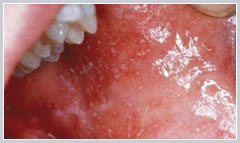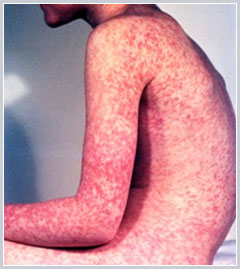Measles is a highly contagious, serious disease caused by the measles virus. It remains one of the leading causes of death among young children globally, despite the availability of a safe and effective vaccine. In New Zealand most recent cases have been imported, with outbreaks occurring in non-vaccinated individuals.
The first sign of measles is usually a high fever, which begins about 10-12 days after exposure to the virus, and may last 4-7 days. A runny nose, a cough, red and watery eyes and small white spots in the cheeks (Koplik’s spots) can develop in the initial stage.

Lesions called Koplik’s spots on the mucous membrane of the mouth are irregular, patchy erythema with tiny white specks (‘grain of salt’ appearance).
After several days, a rash erupts, usually on the face and upper neck. Over about 3 days, the rash spreads, eventually reaching the hands and feet. The rash lasts for 5-6 days, and then fades. On average, the rah occurs 14 days after exposure to the virus (within a range of 7-18 days).

Maculopapular rash in red colour appearing first on the face and then descending to the trunk and arms/legs, which gradually turns brown.
The highly contagious virus is spread by coughing and sneezing, close personal contact or direct contact with infected nasal or throat secretions. It can be transmitted by an infected person from 4 days prior to the onset of the rash to 4 days after the rash erupts.
Any person with fever 38°C or higher, generalised maculopapular rash lasting 3 or more days and/or cough, coryza, conjunctivitis and Koplik’s spots.
Measles PCR is the test of choice from nasopharyngeal swabs. Measles virus is detectable from 3 days prior to rash onset to between 7-14 days after rash onset. The PCR can distinguish between wild-type and vaccine strain.
Measles IgG and IgM antibodies become positive 1-7 days after rash onset.
Positive Measles IgG with a negative Measles IgM is indicative of previous vaccination or infection.
Molecular epidemiology is used to complement and extend case and outbreak investigation. Respiratory or other samples from measles IgM positive cases are used for measles virus culture and molecular genotyping (measles virus strain identification).